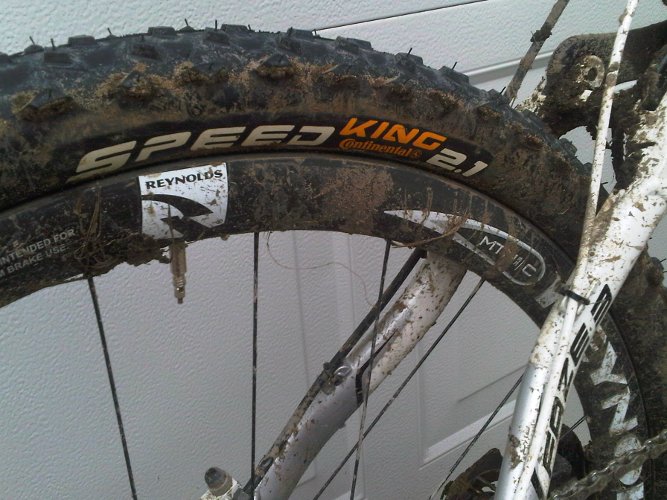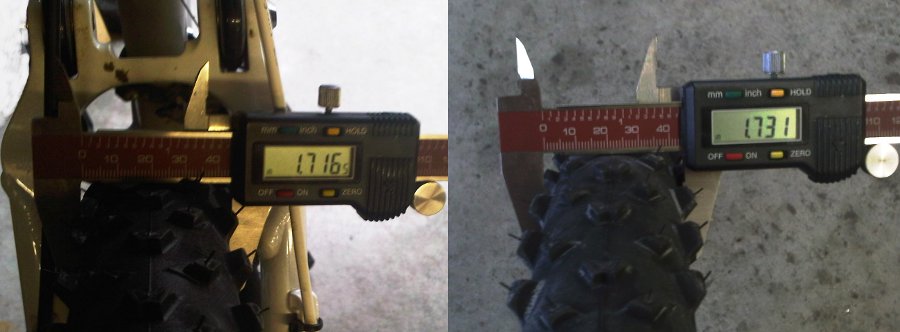
Continental Speed King Supersonic 2.1 Tire Review

For a little over a year, my go-to mountain bike race tire has been the Continental Race King 2.0. But as mentioned in my review the one really serious weakness of the Race King is that it cannot handle mud at all.
This has been one of the wettest springs I've ever seen. Rain almost every day, and the trails are soggy and mushy on the best of days.
I have a race coming up in a week, at Two Creeks. Even if it is hot and sunny all week, it is unlikely that Two Creeks will be completely dry by the time I have to race on it. And that means that the Race King, as good as it is, won't cut it.
So I picked up a set of Continental Speed King Supersonic 2.1" tires. Like the Race Kings, they are built on the "Supersonic" carcass (meaning that it is paper-thin) and they use the soft and sticky "Black Chilli" tread compound. The only real difference is the tread pattern: where the Race King has a very "round" profile with lots of small, tightly-spaced knobs, the Speed King has a more "square" profile, with fewer and taller knobs on the centreline of the tire, and big spiky knobs on the sidewalls.
Unlike the Race King, the Speed King has a "front" and "rear" orientation - same tire front and rear, but the direction of rotation is reversed.
Amazingly, the Speed King is a touch lighter than the Race King:

True to Continental's screwed-up width specs, the nominally 2.1" wide carcass is actually about a tenth of an inch narrower than the nominally 2.0" wide Race King.

My test circuit has a short road ride out to the trails, then has some gravel bike path, and then finally forest singletrack with some sandy sections. In the middle of the singletrack is a short but steep climb up a hill with a half-dozen fall line routes up to the top. These climbs are heavily rutted, and with all the rain the ruts are full of mushy silt and are heavily overgrown with waist-high grass. The singletrack itself varied from moist loam, to sticky mud, to a foot of standing water in a massive puddle.
On the road and the gravel trail, the Speed King was a touch slower than the Race King, and the knobs were making that "frying bacon" sound that a soft knobby tire makes when the knobs are folding over. It was nowhere near as draggy as a Nevregal, and rolled fairly quickly, but not up to the near road-slick quality of a Race King.
Once onto a softer surface where the knobs could penetrate, the tire smoothed right out and got very fast. And thanks to those big shoulder knobs, the tire would grip even when heeled over and loaded up. I started looking for situations where I knew the Race King would wash out and dump me, and no matter how hard I tried, the Speed King never slipped.
But the real eye opener was that sloppy messy hill, I tried it last week on the Race Kings, made it about a bike length up the first slope, and then the tire broke loose and I was on a stationary trainer. In the same conditions, the Speed King gripped and held on. It broke loose a couple of times on hard standing power strokes, but would re-grip and keep on climbing. Each climb was an exercise in riding the edge of disaster as I ricocheted from invisible slop-filled rut to invisible slop-filled rut, but the Speed King held on and I made each attempt.
Subsequent rides in various kinds of slop have confirmed my initial impressions - if the surface is soft enough for the knobs to dig in, this tire will hook up. And the large spaces between knobs help the mud to quickly clear itself out.
When properly matched to conditions, this is a great tire.
Because the compound is so soft and the centre knobs as tall as they are, this tire wears very quickly on the road. This makes it unsuitable for a "general purpose" tire the way the Race King can be. But for conditions ranging from soft loam to outright muck, this is the tire to be on. It accelerates quickly, rolls insanely fast, and corners like Velcro.
Hard cornering on hardpack can get pretty sketchy, as those tall shoulder knobs fold over and squirm.
Much like my race car days when we had the "dry tire" and the "wet tire", a set of Race Kings and a set of Speed Kings should cover the conditions spectrum. The Race King is the paved/dry/hardpack/gravel/rock/moist loam tire, and the Speed King is the moist loam/soft/wet/mud tire. Match the tire to conditions, and go fast.
Sadly, it appears that Continental has discontinued this model so supplies in stores are all that is left. If you can get a set, do it.

|
Buy Continental Race King Tires at 
|
